�
Computer Networking
A Top-Down Approach
Seventh Edition
James F. Kurose
University of Massachusetts, Amherst
Keith W. Ross
NYU and NYU Shanghai
Boston Columbus Indianapolis New York San Francisco Hoboken Amsterdam Cape
Town Dubai London Madrid Milan Munich Paris Montréal Toronto Delhi Mexico City São
Paulo Sydney Hong Kong Seoul Singapore Taipei Tokyo
Vice President, Editorial Director, ECS: Marcia Horton
Acquisitions Editor: Matt Goldstein
Editorial Assistant: Kristy Alaura
Vice President of Marketing: Christy Lesko
Director of Field Marketing: Tim Galligan
Product Marketing Manager: Bram Van Kempen
Field Marketing Manager: Demetrius Hall
Marketing Assistant: Jon Bryant
Director of Product Management: Erin Gregg
Team Lead, Program and Project Management: Scott Disanno
Program Manager: Joanne Manning and Carole Snyder
Project Manager: Katrina Ostler, Ostler Editorial, Inc.
Senior Specialist, Program Planning and Support: Maura Zaldivar-Garcia
Cover Designer: Joyce Wells
Manager, Rights and Permissions: Ben Ferrini
Project Manager, Rights and Permissions: Jenny Hoffman, Aptara Corporation
Inventory Manager: Ann Lam
Cover Image: Marc Gutierrez/Getty Images
Media Project Manager: Steve Wright
Composition: Cenveo Publishing Services
Printer/Binder: Edwards Brothers Malloy
Cover and Insert Printer: Phoenix Color/ Hagerstown
Credits and acknowledgments borrowed from other sources and reproduced, with permission, in this
textbook appear on appropriate page within text.
Copyright © 2017, 2013, 2010 Pearson Education, Inc. All rights reserved. Manufactured in the United States
of America. This publication is protected by Copyright, and permission should be obtained from the publisher
prior to any prohibited reproduction, storage in a retrieval system, or transmission in any form or by any
means, electronic, mechanical, photocopying, recording, or likewise. For information regarding permissions,
request forms and the appropriate contacts within the Pearson Education Global Rights & Permissions
Department, please visit www.pearsoned.com/permissions/. Many of the designations by manufacturers
and seller to distinguish their products are claimed as trademarks. Where those designations appear in this
book, and the publisher was aware of a trademark claim, the designations have been printed in initial caps or
all caps.
Library of Congress Cataloging-in-Publication Data
Names: Kurose, James F. | Ross, Keith W., 1956-
Title: Computer networking: a top-down approach / James F. Kurose, University of Massachusetts, Amherst,
Keith W. Ross, NYU and NYU Shanghai.
Description: Seventh edition. | Hoboken, New Jersey: Pearson, [2017] | Includes bibliographical references
and index.
Identifiers: LCCN 2016004976 | ISBN 9780133594140 | ISBN 0133594149
Subjects: LCSH: Internet. | Computer networks.
Classification: LCC TK5105.875.I57 K88 2017 | DDC 004.6-dc23
�
LC record available at http://lccn.loc.gov/2016004976
ISBN-10: 0-13-359414-9
ISBN-13: 978-0-13-359414-0
About the Authors
Jim Kurose
Jim Kurose is a Distinguished University Professor of Computer Science at the University of Massachusetts,
Amherst. He is currently on leave from the University of Massachusetts, serving as an Assistant Director at the
US National Science Foundation, where he leads the Directorate of Computer and Information Science and
Engineering.
Dr. Kurose has received a number of recognitions for his educational activities including Outstanding Teacher
Awards from the National Technological University (eight times), the University of Massachusetts, and the
Northeast Association of Graduate Schools. He received the IEEE Taylor Booth Education Medal and was
recognized for his leadership of Massachusetts’ Commonwealth Information Technology Initiative. He has won
several conference best paper awards and received the IEEE Infocom Achievement Award and the ACM
Sigcomm Test of Time Award.
Dr. Kurose is a former Editor-in-Chief of IEEE Transactions on Communications and of IEEE/ACM
Transactions on Networking. He has served as Technical Program co-Chair for IEEE Infocom, ACM
SIGCOMM, ACM Internet Measurement Conference, and ACM SIGMETRICS. He is a Fellow of the IEEE and
the ACM. His research interests include network protocols and architecture, network measurement,
multimedia communication, and modeling and performance evaluation. He holds a PhD in Computer Science
from Columbia University.
Keith Ross
�
Keith Ross is the Dean of Engineering and Computer Science at NYU Shanghai and the Leonard J. Shustek
Chair Professor in the Computer Science and Engineering Department at NYU. Previously he was at
University of Pennsylvania (13 years), Eurecom Institute (5 years) and Polytechnic University (10 years). He
received a B.S.E.E from Tufts University, a M.S.E.E. from Columbia University, and a Ph.D. in Computer and
Control Engineering from The University of Michigan. Keith Ross is also the co-founder and original CEO of
Wimba, which develops online multimedia applications for e-learning and was acquired by Blackboard in 2010.
Professor Ross’s research interests are in privacy, social networks, peer-to-peer networking, Internet
measurement, content distribution networks, and stochastic modeling. He is an ACM Fellow, an IEEE Fellow,
recipient of the Infocom 2009 Best Paper Award, and recipient of 2011 and 2008 Best Paper Awards for
Multimedia Communications (awarded by IEEE Communications Society). He has served on numerous journal
editorial boards and conference program committees, including IEEE/ACM Transactions on Networking, ACM
SIGCOMM, ACM CoNext, and ACM Internet Measurement Conference. He also has served as an advisor to
the Federal Trade Commission on P2P file sharing.
To Julie and our three precious ones—Chris, Charlie, and Nina
JFK
A big THANKS to my professors, colleagues, and students all over the world.
KWR
Preface
Welcome to the seventh edition of Computer Networking: A Top-Down Approach. Since the publication of the
first edition 16 years ago, our book has been adopted for use at many hundreds of colleges and universities,
translated into 14 languages, and used by over one hundred thousand students and practitioners worldwide.
We’ve heard from many of these readers and have been overwhelmed by the positive response.
�
What’s New in the Seventh Edition?
We think one important reason for this success has been that our book continues to offer a fresh and timely
approach to computer networking instruction. We’ve made changes in this seventh edition, but we’ve also kept
unchanged what we believe (and the instructors and students who have used our book have confirmed) to be
the most important aspects of this book: its top-down approach, its focus on the Internet and a modern
treatment of computer networking, its attention to both principles and practice, and its accessible style and
approach toward learning about computer networking. Nevertheless, the seventh edition has been revised and
updated substantially.
Long-time readers of our book will notice that for the first time since this text was published, we’ve changed the
organization of the chapters themselves. The network layer, which had been previously covered in a single
chapter, is now covered in Chapter 4 (which focuses on the so-called “data plane” component of the network
layer) and Chapter 5 (which focuses on the network layer’s “control plane”). This expanded coverage of the
network layer reflects the swift rise in importance of software-defined networking (SDN), arguably the most
important and exciting advance in networking in decades. Although a relatively recent innovation, SDN has
been rapidly adopted in practice—so much so that it’s already hard to imagine an introduction to modern
computer networking that doesn’t cover SDN. The topic of network management, previously covered in
Chapter 9, has now been folded into the new Chapter 5. As always, we’ve also updated many other sections
of the text to reflect recent changes in the dynamic field of networking since the sixth edition. As always,
material that has been retired from the printed text can always be found on this book’s Companion Website.
The most important updates are the following:
Chapter 1 has been updated to reflect the ever-growing reach and use of the Internet.
Chapter 2, which covers the application layer, has been significantly updated. We’ve removed the material
on the FTP protocol and distributed hash tables to make room for a new section on application-level video
streaming and content distribution networks, together with Netflix and YouTube case studies. The
socket programming sections have been updated from Python 2 to Python 3.
Chapter 3, which covers the transport layer, has been modestly updated. The material on asynchronous
transport mode (ATM) networks has been replaced by more modern material on the Internet’s explicit
congestion notification (ECN), which teaches the same principles.
Chapter 4 covers the “data plane” component of the network layer—the per-router forwarding function that
determine how a packet arriving on one of a router’s input links is forwarded to one of that router’s output
links. We updated the material on traditional Internet forwarding found in all previous editions, and added
material on packet scheduling. We’ve also added a new section on generalized forwarding, as practiced in
SDN. There are also numerous updates throughout the chapter. Material on multicast and broadcast
communication has been removed to make way for the new material.
In Chapter 5, we cover the control plane functions of the network layer—the network-wide logic that
controls how a datagram is routed along an end-to-end path of routers from the source host to the
destination host. As in previous editions, we cover routing algorithms, as well as routing protocols (with an
updated treatment of BGP) used in today’s Internet. We’ve added a significant new section on the SDN
control plane, where routing and other functions are implemented in so-called SDN controllers.
Chapter 6, which now covers the link layer, has an updated treatment of Ethernet, and of data center
networking.
Chapter 7, which covers wireless and mobile networking, contains updated material on 802.11 (so-called
“WiFi) networks and cellular networks, including 4G and LTE.
Chapter 8, which covers network security and was extensively updated in the sixth edition, has only
�
modest updates in this seventh edition.
Chapter 9, on multimedia networking, is now slightly “thinner” than in the sixth edition, as material on video
streaming and content distribution networks has been moved to Chapter 2, and material on packet
scheduling has been incorporated into Chapter 4.
Significant new material involving end-of-chapter problems has been added. As with all previous editions,
homework problems have been revised, added, and removed.
As always, our aim in creating this new edition of our book is to continue to provide a focused and modern
treatment of computer networking, emphasizing both principles and practice.
Audience
This textbook is for a first course on computer networking. It can be used in both computer science and
electrical engineering departments. In terms of programming languages, the book assumes only that the
student has experience with C, C++, Java, or Python (and even then only in a few places). Although this book
is more precise and analytical than many other introductory computer networking texts, it rarely uses any
mathematical concepts that are not taught in high school. We have made a deliberate effort to avoid using any
advanced calculus, probability, or stochastic process concepts (although we’ve included some homework
problems for students with this advanced background). The book is therefore appropriate for undergraduate
courses and for first-year graduate courses. It should also be useful to practitioners in the telecommunications
industry.
What Is Unique About This Textbook?
The subject of computer networking is enormously complex, involving many concepts, protocols, and
technologies that are woven together in an intricate manner. To cope with this scope and complexity, many
computer networking texts are often organized around the “layers” of a network architecture. With a layered
organization, students can see through the complexity of computer networking—they learn about the distinct
concepts and protocols in one part of the architecture while seeing the big picture of how all parts fit together.
From a pedagogical perspective, our personal experience has been that such a layered approach indeed
works well. Nevertheless, we have found that the traditional approach of teaching—bottom up; that is, from the
physical layer towards the application layer—is not the best approach for a modern course on computer
networking.
A Top-Down Approach
Our book broke new ground 16 years ago by treating networking in a top-down manner—that is, by
beginning at the application layer and working its way down toward the physical layer. The feedback we
received from teachers and students alike have confirmed that this top-down approach has many advantages
and does indeed work well pedagogically. First, it places emphasis on the application layer (a “high growth
area” in networking). Indeed, many of the recent revolutions in computer networking—including the Web,
peer-to-peer file sharing, and media streaming—have taken place at the application layer. An early emphasis
on application-layer issues differs from the approaches taken in most other texts, which have only a small
amount of material on network applications, their requirements, application-layer paradigms (e.g., client-server
and peer-to-peer), and application programming interfaces. Second, our experience as instructors (and that
of many instructors who have used this text) has been that teaching networking applications near the
beginning of the course is a powerful motivational tool. Students are thrilled to learn about how networking
�
applications work—applications such as e-mail and the Web, which most students use on a daily basis. Once
a student understands the applications, the student can then understand the network services needed to
support these applications. The student can then, in turn, examine the various ways in which such services
might be provided and implemented in the lower layers. Covering applications early thus provides motivation
for the remainder of the text.
Third, a top-down approach enables instructors to introduce network application development at an early
stage. Students not only see how popular applications and protocols work, but also learn how easy it is to
create their own network applications and application-level protocols. With the top-down approach, students
get early exposure to the notions of socket programming, service models, and protocols—important
concepts that resurface in all subsequent layers. By providing socket programming examples in Python, we
highlight the central ideas without confusing students with complex code. Undergraduates in electrical
engineering and computer science should not have difficulty following the Python code.
An Internet Focus
Although we dropped the phrase “Featuring the Internet” from the title of this book with the fourth edition, this
doesn’t mean that we dropped our focus on the Internet. Indeed, nothing could be further from the case!
Instead, since the Internet has become so pervasive, we felt that any networking textbook must have a
significant focus on the Internet, and thus this phrase was somewhat unnecessary. We continue to use the
Internet’s architecture and protocols as primary vehicles for studying fundamental computer networking
concepts. Of course, we also include concepts and protocols from other network architectures. But the
spotlight is clearly on the Internet, a fact reflected in our organizing the book around the Internet’s five-layer
architecture: the application, transport, network, link, and physical layers.
Another benefit of spotlighting the Internet is that most computer science and electrical engineering students
are eager to learn about the Internet and its protocols. They know that the Internet has been a revolutionary
and disruptive technology and can see that it is profoundly changing our world. Given the enormous relevance
of the Internet, students are naturally curious about what is “under the hood.” Thus, it is easy for an instructor
to get students excited about basic principles when using the Internet as the guiding focus.
Teaching Networking Principles
Two of the unique features of the book—its top-down approach and its focus on the Internet—have appeared
in the titles of our book. If we could have squeezed a third phrase into the subtitle, it would have contained the
word principles. The field of networking is now mature enough that a number of fundamentally important issues
can be identified. For example, in the transport layer, the fundamental issues include reliable communication
over an unreliable network layer, connection establishment/ teardown and handshaking, congestion and flow
control, and multiplexing. Three fundamentally important network-layer issues are determining “good” paths
between two routers, interconnecting a large number of heterogeneous networks, and managing the
complexity of a modern network. In the link layer, a fundamental problem is sharing a multiple access channel.
In network security, techniques for providing confidentiality, authentication, and message integrity are all based
on cryptographic fundamentals. This text identifies fundamental networking issues and studies approaches
towards addressing these issues. The student learning these principles will gain knowledge with a long “shelf
life”—long after today’s network standards and protocols have become obsolete, the principles they embody
will remain important and relevant. We believe that the combination of using the Internet to get the student’s
foot in the door and then emphasizing fundamental issues and solution approaches will allow the student to
�
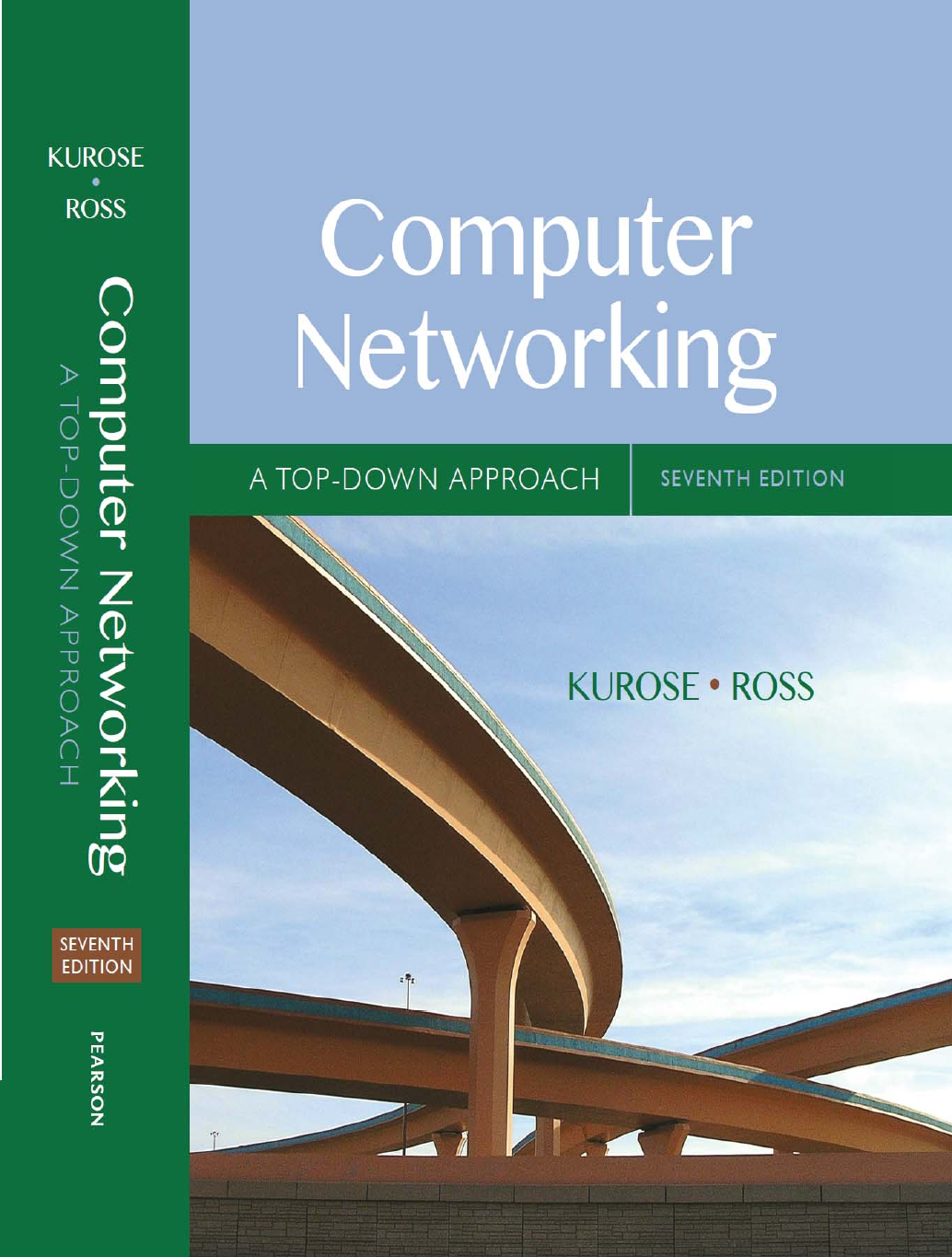
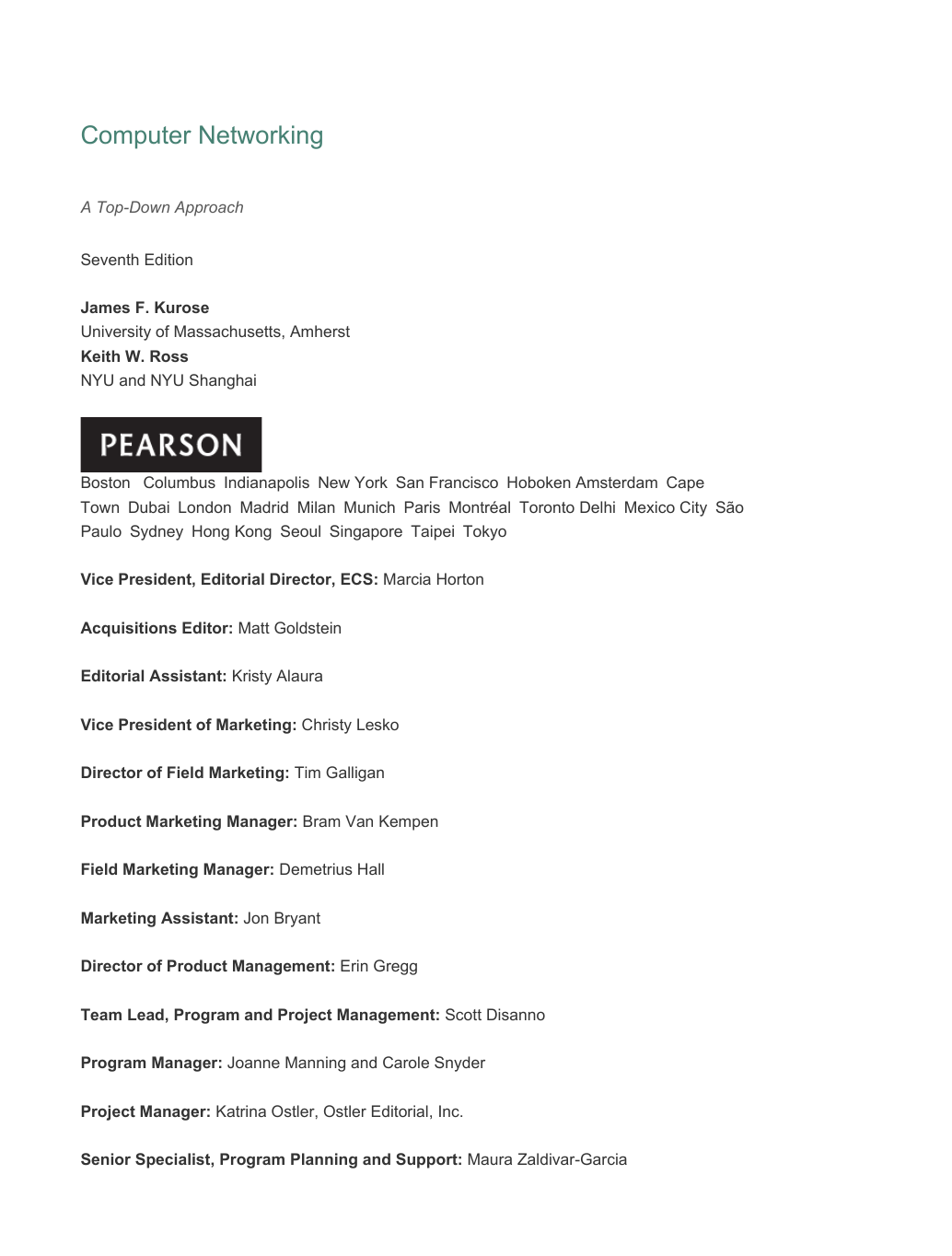
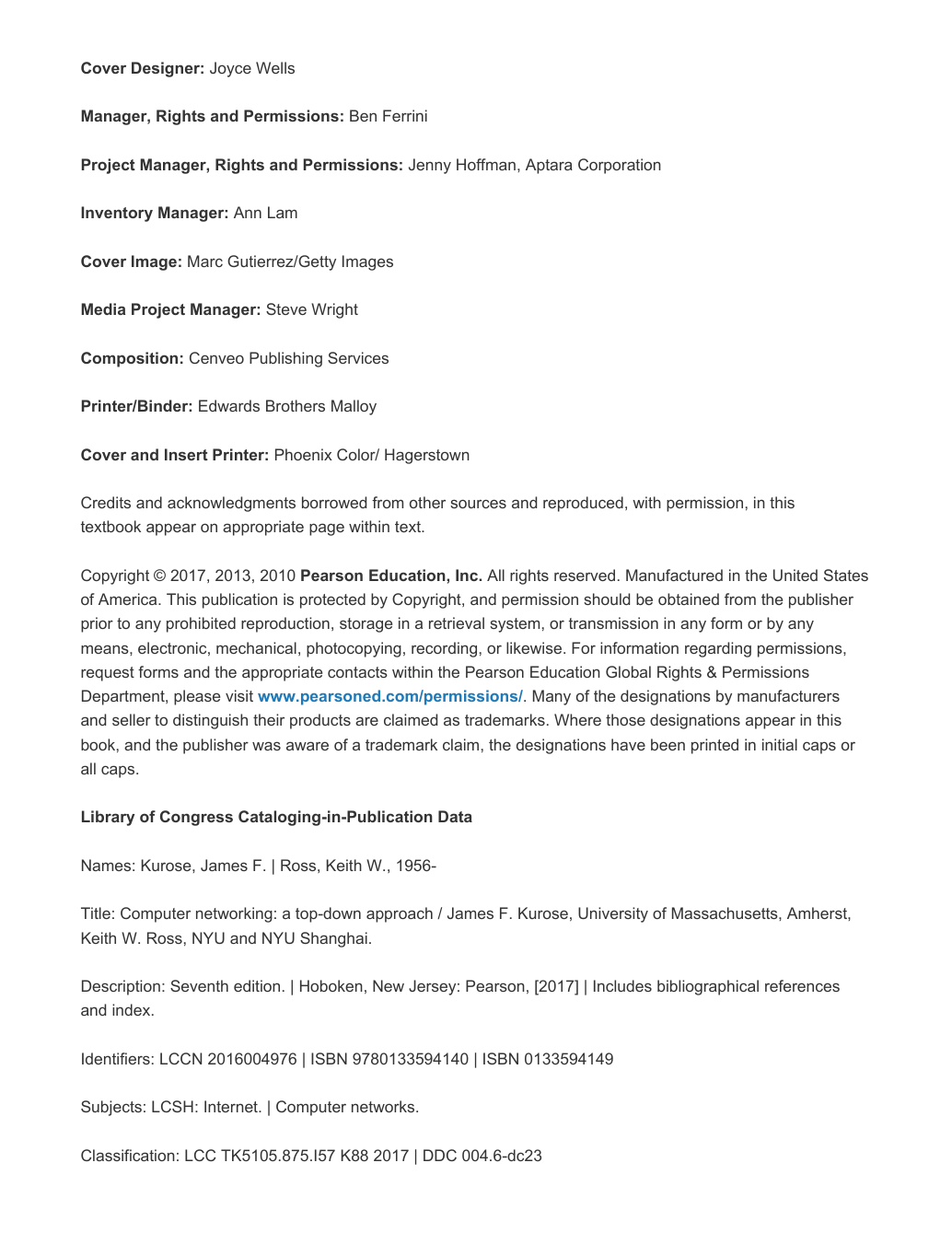

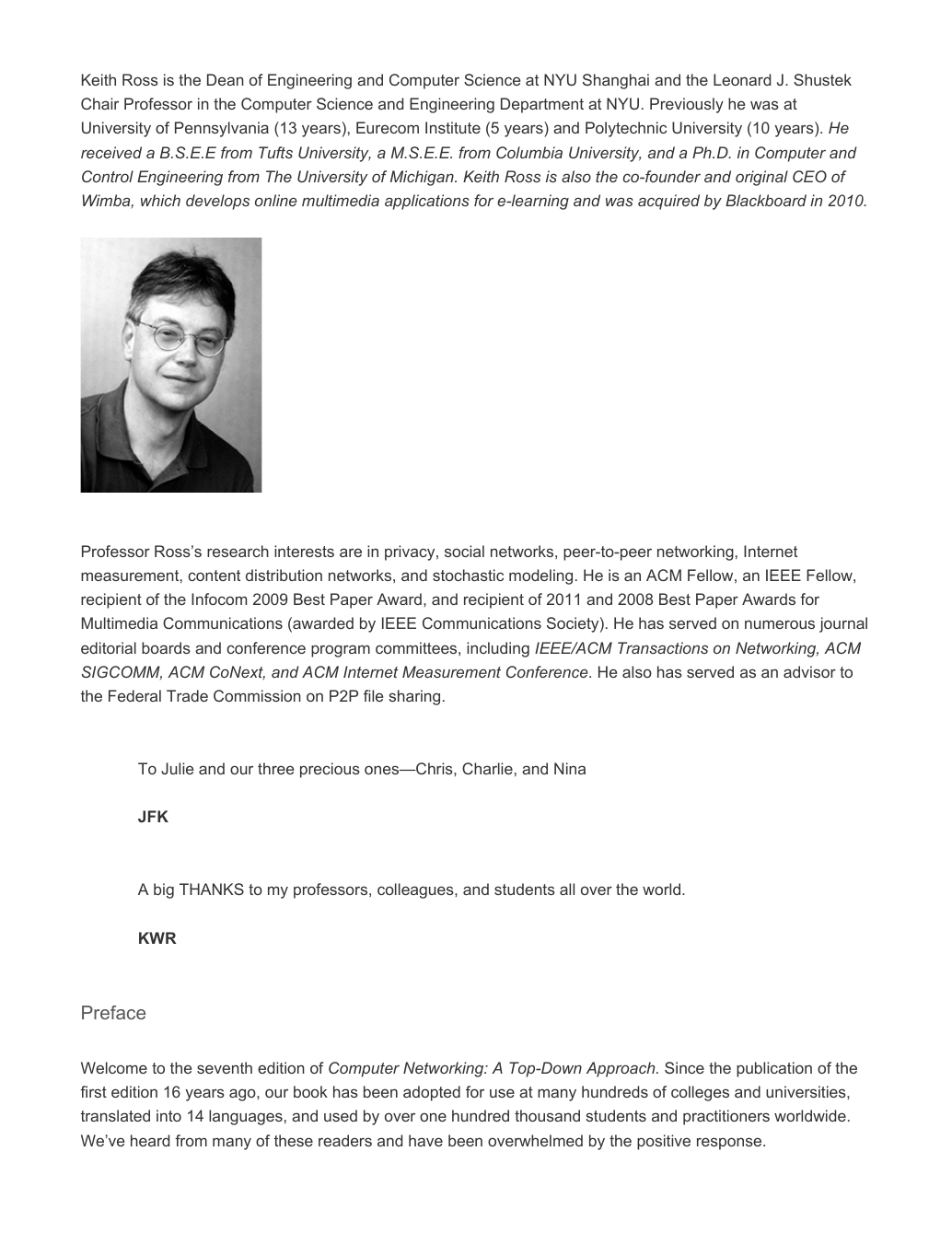
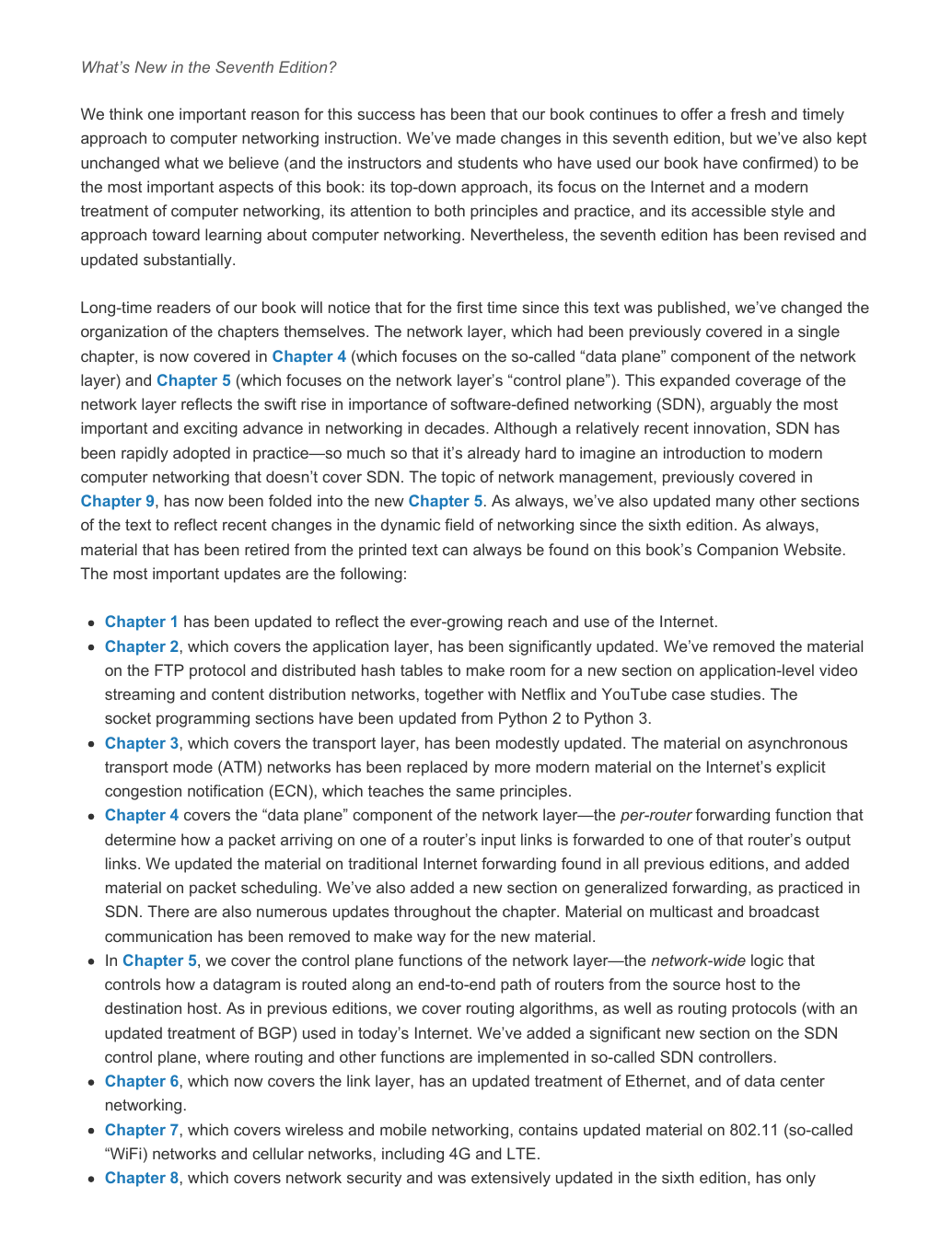
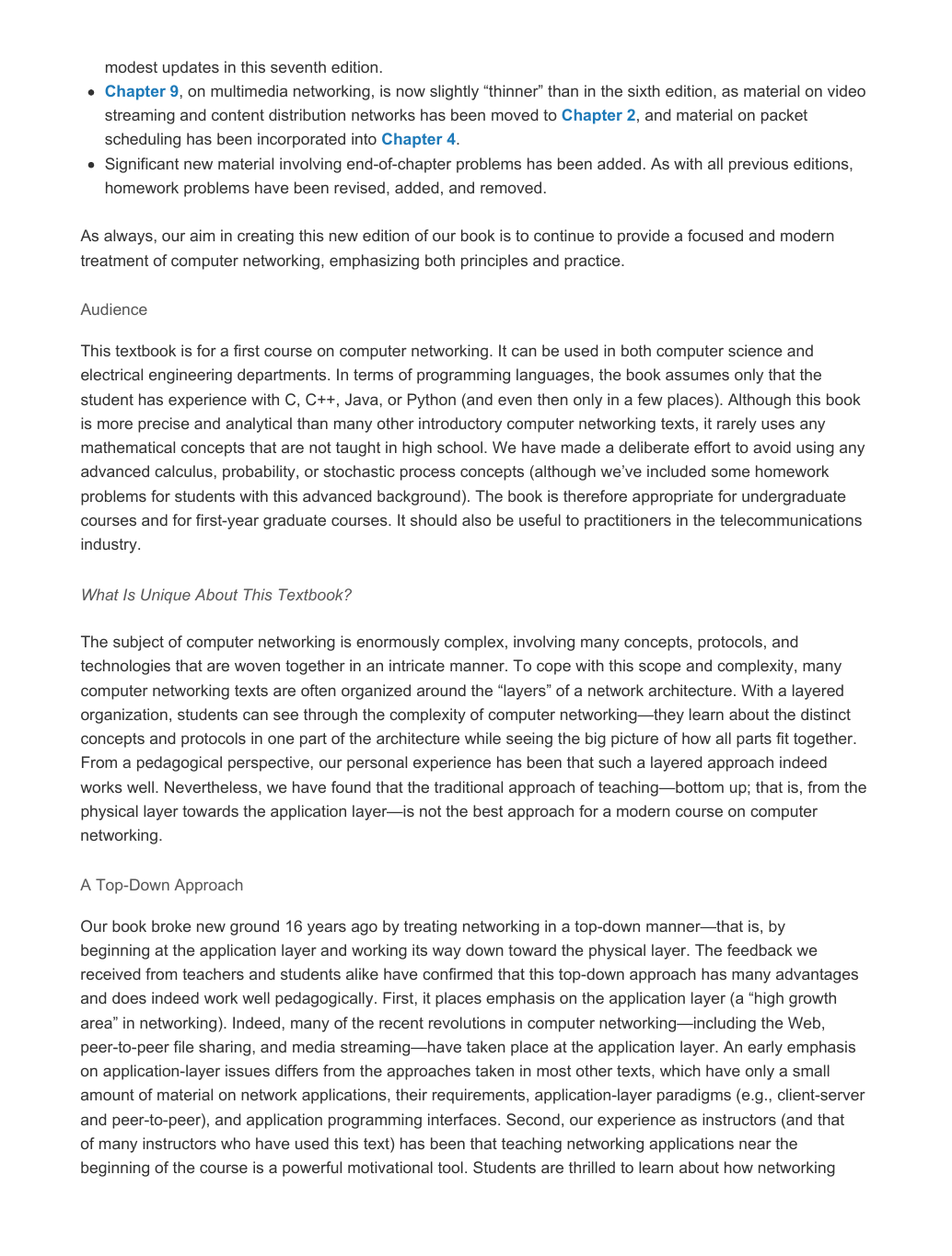
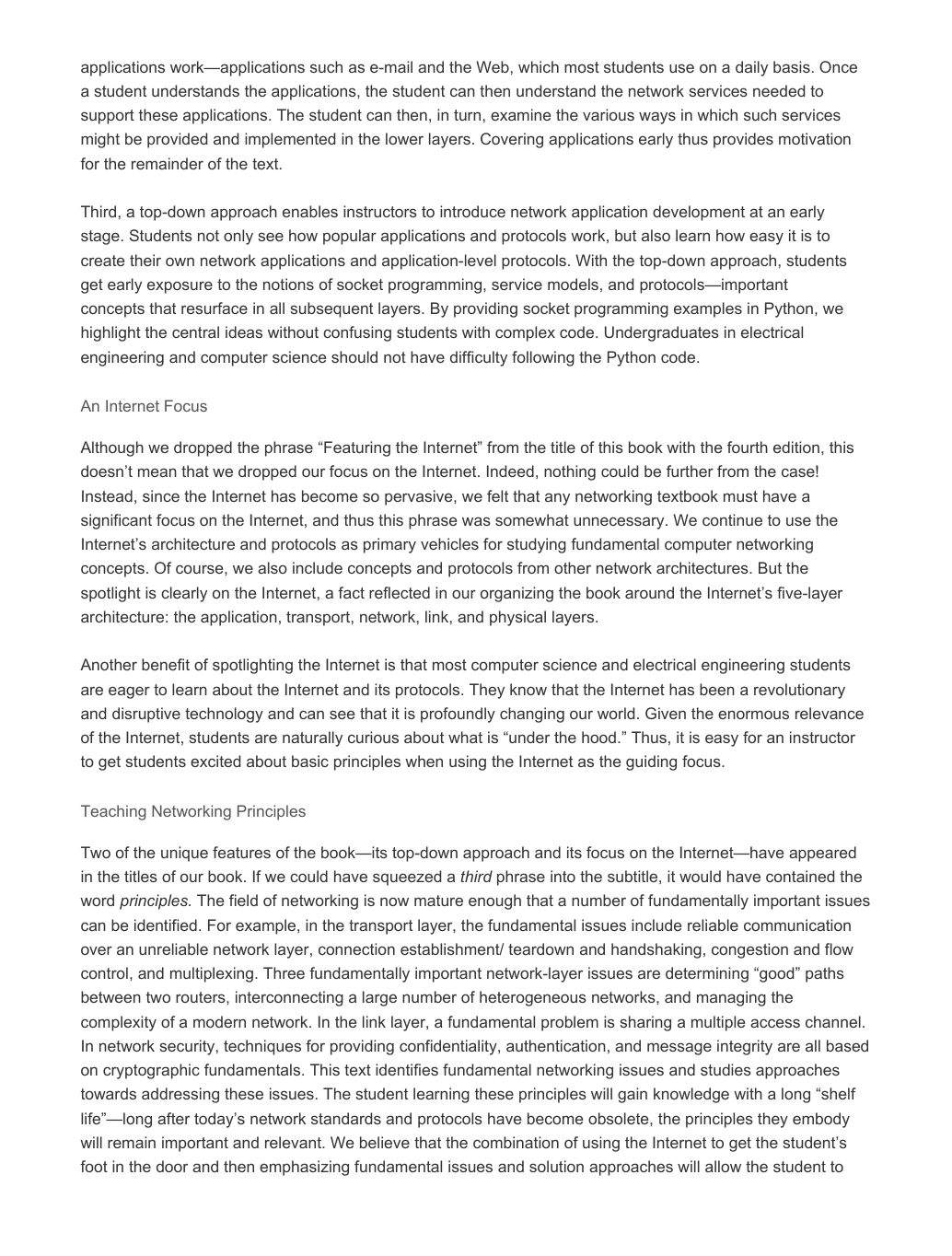








 2023年江西萍乡中考道德与法治真题及答案.doc
2023年江西萍乡中考道德与法治真题及答案.doc 2012年重庆南川中考生物真题及答案.doc
2012年重庆南川中考生物真题及答案.doc 2013年江西师范大学地理学综合及文艺理论基础考研真题.doc
2013年江西师范大学地理学综合及文艺理论基础考研真题.doc 2020年四川甘孜小升初语文真题及答案I卷.doc
2020年四川甘孜小升初语文真题及答案I卷.doc 2020年注册岩土工程师专业基础考试真题及答案.doc
2020年注册岩土工程师专业基础考试真题及答案.doc 2023-2024学年福建省厦门市九年级上学期数学月考试题及答案.doc
2023-2024学年福建省厦门市九年级上学期数学月考试题及答案.doc 2021-2022学年辽宁省沈阳市大东区九年级上学期语文期末试题及答案.doc
2021-2022学年辽宁省沈阳市大东区九年级上学期语文期末试题及答案.doc 2022-2023学年北京东城区初三第一学期物理期末试卷及答案.doc
2022-2023学年北京东城区初三第一学期物理期末试卷及答案.doc 2018上半年江西教师资格初中地理学科知识与教学能力真题及答案.doc
2018上半年江西教师资格初中地理学科知识与教学能力真题及答案.doc 2012年河北国家公务员申论考试真题及答案-省级.doc
2012年河北国家公务员申论考试真题及答案-省级.doc 2020-2021学年江苏省扬州市江都区邵樊片九年级上学期数学第一次质量检测试题及答案.doc
2020-2021学年江苏省扬州市江都区邵樊片九年级上学期数学第一次质量检测试题及答案.doc 2022下半年黑龙江教师资格证中学综合素质真题及答案.doc
2022下半年黑龙江教师资格证中学综合素质真题及答案.doc